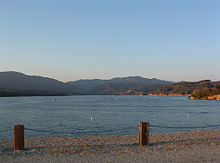Castaic Dam
The lake has a capacity of 325,000 acre-feet (401,000,000 m3) and stores drinking water for the western portion of the Greater Los Angeles Area.
Water drawn from the Sacramento–San Joaquin River Delta is transported down the San Joaquin Valley via the California Aqueduct and pumped over the Tehachapi Mountains, where it splits into the East Branch – providing water for Riverside and San Bernardino and eastern Los Angeles Counties – and the West Branch, which supplies western Los Angeles and parts of Ventura County.
[8] During normal operations, Castaic Lake serves as a regulatory reservoir for water delivered through the California Aqueduct, releasing it at times of peak demand.
However, the dam and lake was also built to provide a pool of "emergency storage" that can be drawn down if water deliveries from northern California are interrupted, whether due to construction, equipment malfunction or severe drought.
As many as 12 million people in these areas receive their full or supplemental water supply from Castaic Lake and the feeder system.
The service area covers about 195 square miles (510 km2) in Ventura and north Los Angeles counties, providing water to about 287,000 people.
[13] The 11 MW Foothill Feeder hydroelectric power plant is located at the base of the dam and generates electricity when water is needed in Los Angeles.
[16] Due to seismic vulnerabilities, and its proximity to the San Andreas Fault, the dam has one of the lowest safety ratings in Los Angeles County.
